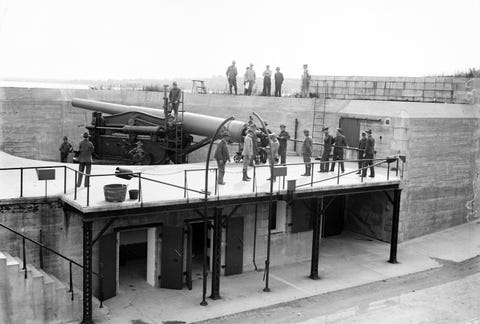The U.S. Army Is Learning to Take Out Warships Again
Adversaries with powerful, capable navies are forcing the Army to look seaward again.
By Kyle Mizokami
KONGSBERG/RAYTHEON
More than half a century after it gave up the mission, the U.S. Army is once again learning to keep enemy fleets at bay using modern firepower. During the July 2018 exercise to sink the ex-USS Racine, a Army crew fired a Naval Strike Missile at the ship, striking it. The goal is to deny enemy fleets the ability to operate near land masses–particularly islands–occupied by U.S. ground forces.
The RIMPAC SINKEX, or “sinking exercise”, saw a U.S. Army crew fire a Norwegian-made Naval Strike Missile from the back of a heavy truck. A new weapon system, the Naval Strike Missile (NSM) was recently selected to equip the U.S. Navy’s littoral combat ships and future frigates. It can also be launched from the F-35 Joint Strike Fighter. The NSM struck the ex-USS Racine at a range of approximately 55 miles. Here's a video of a NSM launching from the USS Coronado in 2014:
https://www.youtube.com/watch?v=UuMU-lc8DZw
For decades, the U.S. Army manned coastal defenses in the continental United States, Hawaii, and abroad. These defenses typically included large artillery guns overlooking strategic locations such as San Francisco Bay, New York Harbor, Boston Harbor, Hawaii, the Panama Canal, and the Philippines. Shortly before World War II, the mission grew to include anti-aircraft defense. The domination of the seas by the U.S. Navy and the rise of nuclear weapons led to the disbandment of the Coast Artillery Corps in 1950.
Today, the rise of the Chinese Navy and the focus of the Russian surface navy on coastal operations has the U.S. and its allies–particularly Japan–wondering how to best keep enemy fleets at bay. Adversaries might conduct amphibious operations in places like the South China Sea and the Baltic Sea, snatching strategically important islands or stretches of coastline. While air and naval forces are one obvious defense, land-based anti-ship missiles could make amphibious assaults too risky to attempt.

A coastal artillery gun at Fort Hamilton, New York.
WIKIMEDIA COMMONS
Land-based anti-ship missiles are useful for other reasons. They contribute to the war at sea by restricting an enemy fleet’s movements. A single Naval Strike Missile battery with a range of 100 nautical miles can sit on a tiny island and keep the enemy out of 31,415 square miles of nearby water. Forced to maintain its distance from land masses, enemy fleets could be herded into places where they are vulnerable to attacks from friendly ships, aircraft, and submarines. Land-based anti-ship weapon also allow the U.S. Navy to concentrate on the open water.
There’s no telling if and when the U.S. Army will stand up new coast artillery units. We only know the capability is being explored. The mission might even go to the Marine Corps, which although generally an offensive tool has been given the island defense mission before-–see the heroic defense of Wake Island from Japanese forces in 1942. Whoever it goes to, the mission is here and isn’t going away.
No comments:
Post a Comment